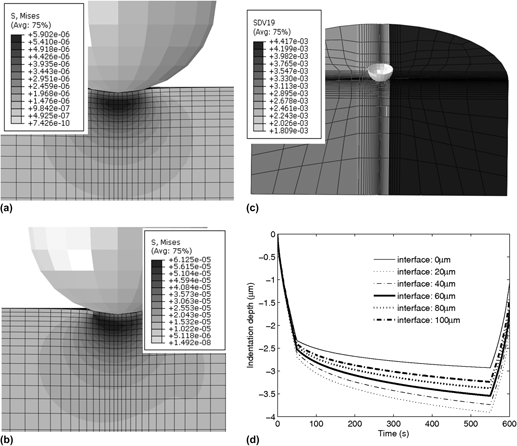Crossref Citations
This article has been cited by the following publications. This list is generated based on data provided by
Crossref.
Chen, X.
Ashcroft, I.A.
Tuck, C.J.
He, Y.F.
Hague, R.J.M.
and
Wildman, R.D.
2017.
An investigation into the depth and time dependent behavior of UV cured 3D ink jet printed objects – CORRIGENDUM.
Journal of Materials Research,
Vol. 32,
Issue. 13,
p.
2629.
Gao, Chenghui
and
Liu, Ming
2017.
Power law creep of polycarbonate by Berkovich nanoindentation.
Materials Research Express,
Vol. 4,
Issue. 10,
p.
105302.
Hammerquist, Chad C.
and
Nairn, John A.
2018.
Modeling nanoindentation using the Material Point Method.
Journal of Materials Research,
Vol. 33,
Issue. 10,
p.
1369.
Picha, Kyle
and
Samuel, Johnson
2018.
A model-based prediction of droplet shape evolution during additive manufacturing of aligned fiber-reinforced soft composites.
Journal of Manufacturing Processes,
Vol. 32,
Issue. ,
p.
816.
Gao, Chenghui
Yao, Ligang
and
Liu, Ming
2018.
Berkovich nanoindentation of borosilicate K9 glass.
Optical Engineering,
Vol. 57,
Issue. 03,
p.
1.
Zhao, Zeang
Wu, Dong
Chen, Hao-Sen
Jerry Qi, H.
and
Fang, Daining
2020.
Indentation experiments and simulations of nonuniformly photocrosslinked polymers in 3D printed structures.
Additive Manufacturing,
Vol. 35,
Issue. ,
p.
101420.
Mensov, Sergey Nickolayevich
Abakumov, Gleb A.
Arsenyev, Maxim V.
Baten'kin, Maxim A.
Chesnokov, Sergey A.
Konev, Alexey N.
Polushtaytsev, Yuri V.
Shurygina, Margarita P.
and
Zakharina, Maria Yu.
2020.
Use of photodegradable inhibitors in UV‐curable compositions to form polymeric 2D‐structures by visible light.
Journal of Applied Polymer Science,
Vol. 137,
Issue. 34,
Tee, Yun Lu
Peng, Chenxi
Pille, Philip
Leary, Martin
and
Tran, Phuong
2020.
PolyJet 3D Printing of Composite Materials: Experimental and Modelling Approach.
JOM,
Vol. 72,
Issue. 3,
p.
1105.
Zhao, Peng
He, Yinfeng
Trindade, Gustavo F.
Baumers, Martin
Irvine, Derek J.
Hague, Richard J.M.
Ashcroft, Ian A.
and
Wildman, Ricky D.
2021.
Modelling the influence of UV curing strategies for optimisation of inkjet based 3D printing.
Materials & Design,
Vol. 208,
Issue. ,
p.
109889.
Schlotthauer, Tristan
Nitsche, Jan
and
Middendorf, Peter
2021.
Evaluation of UV post-curing depth for homogenous cross-linking of stereolithography parts.
Rapid Prototyping Journal,
Vol. 27,
Issue. 10,
p.
1910.
Jambhapuram, Manogna
Good, James K.
and
Azoug, Aurélie
2022.
Impact of winding on nanoimprinted surfaces in roll‐to‐roll nanoimprint lithography.
Polymer Engineering & Science,
Vol. 62,
Issue. 8,
p.
2657.
Tran, H.S.
Bouffioux, C.
Dedry, O.
Rojas-Ulloa, C.
Duchêne, L.
Mertens, A.
and
Habraken, A.M.
2022.
Identification of a soft matrix-hard inclusion material by indentation.
International Journal of Mechanical Sciences,
Vol. 235,
Issue. ,
p.
107723.
Elkaseer, Ahmed
Chen, Karin J.
Janhsen, Jan C.
Refle, Oliver
Hagenmeyer, Veit
and
Scholz, Steffen G.
2022.
Material jetting for advanced applications: A state-of-the-art review, gaps and future directions.
Additive Manufacturing,
Vol. 60,
Issue. ,
p.
103270.
Elkaseer, Ahmed
Chen, Karin J.
Kuchta, Matthias
and
Scholz, Steffen G.
2023.
On the quantitative assessment of the effect of multiple process parameters on the printed layer height in 3D inkjet printing.
Virtual and Physical Prototyping,
Vol. 18,
Issue. 1,
Bezek, Lindsey B.
and
Williams, Christopher B.
2023.
Process-structure-property effects of ultraviolet curing in multi-material jetting additive manufacturing.
Additive Manufacturing,
Vol. 73,
Issue. ,
p.
103640.
Sekmen, Kubra
Rehbein, Thomas
Johlitz, Michael
Lion, Alexander
and
Constantinescu, Andrei
2024.
Thermal analysis and shrinkage characterization of the photopolymers for DLP additive manufacturing processes.
Continuum Mechanics and Thermodynamics,
Vol. 36,
Issue. 2,
p.
351.
Samaitis, Vykintas
Merfeldas, Audrius
Jankauskas, Audrius
Raišutis, Renaldas
and
Jasiu̅nienė, Elena
2025.
From Print to Performance: A Comparative Study of Conductive and Radiated Emissions in FR-4 PCB Technology versus Dragonfly IV Additively Manufactured Electronics.
ACS Applied Electronic Materials,
Vol. 7,
Issue. 4,
p.
1381.




